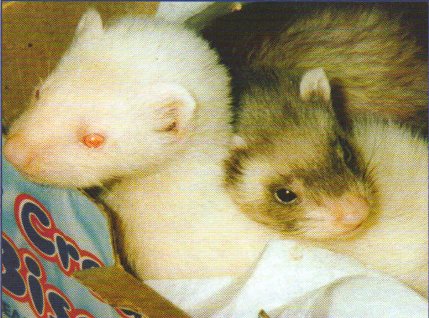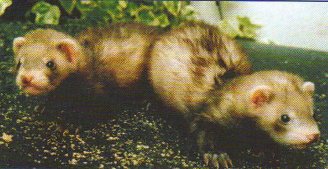Ferrets First - Breeding Ferrets
Spring is the time of year when ferrets start to breed. MICHAEL SANDERSON takes us through this fascinating subject but urges us all to think very carefully before allowing our jills to become pregnant
We are approaching that time of year when ferrets become sexually active. As the dark winter mornings and evenings surrender to the light of spring, the pituitary gland in the ferret's brain begins to secrete hormones which in turn will trigger changes to its reproductive species.
 Hobs are the first to come into season. Not too long after the days start to lengthen, the hob's testes will descend from the abdomen and begin to produce spermatoza. This usually occurs at the beginning of January and the testes take around 2-3 months to develop fully, bringing them into fertility between March and April. The hob responds to a short day length, starting to come into season after the shortest day. Jills respond to the extended light of early spring, coming into season well after the hobs. They require at least 14 hours of continous light to trigger the hormone release in the brain. Jills are likely to start coming into season around the end of March. This sensitivity to the length of day is known as photoperiodism and is seen in many mammals. Because of this light sensitivity, ferrets kept indoors may come in and out of season all year round.
Hobs are the first to come into season. Not too long after the days start to lengthen, the hob's testes will descend from the abdomen and begin to produce spermatoza. This usually occurs at the beginning of January and the testes take around 2-3 months to develop fully, bringing them into fertility between March and April. The hob responds to a short day length, starting to come into season after the shortest day. Jills respond to the extended light of early spring, coming into season well after the hobs. They require at least 14 hours of continous light to trigger the hormone release in the brain. Jills are likely to start coming into season around the end of March. This sensitivity to the length of day is known as photoperiodism and is seen in many mammals. Because of this light sensitivity, ferrets kept indoors may come in and out of season all year round.
When hobs come into season, as long as they are isolated from other ferrets, there is nothing to do or worry about.
This is not the case with jills. As the jill comes into season, or oestrus, the vulva will become swollen and the jill must be brought out of season. Most female animals produce eggs regardless of whether or not any stimulation takes place. The egg is released, ripens in the uterus, and is then flushed out if it is not fertilised. An egg will only be fertilised at the exact time when the egg is totally ripe. This process, called spontaneous ovulation, is very and miss and more likely to fail. The process happens on a continuous cycle and is the method used by the human reproductive system. In the wild, however, polecats are solitary. The likelihood of a male being around at the exact time that the egg is ripe is extremely small. Ferrets, therefore adopt another method called induced ovulation. Ovulation will not occur in ferrets until a specific stimulation is applied to induce the release of eggs. This precess is very successful for breeding. Until stimulation is applied, the ripe eggs will remain in the ovaries. Once the eggs are released, oestrus is terminated. When a season is not terminated until ovulation it is called polyoestrus. In birds the mating call of the male induces ovulation. In the case of the ferret the stimulation required is that of the mating ritual itself. This has huge implications. If the jill is not brought out of season she will eventually develop cancer and die. Nowadays, this is no problem. Hobs can be vasectomised to terminate oestrus without fertisation or hormonal injections can be given to induce ovulation.
Because of the other options available, there is no need to breed. Breeding should only be done if you feel you have the experience with ferrets, the time, the patience and the commitment. You must also be able to offer good homes to all the offspring, bearing in mind that a jill can have up to 14 kits, although the average litter is about eight. You must also
 expect that your beloved jill may end up giving her life if there are any complications and you must then hand-rear the kits, feeding them every two hours for the first few weeks. Generally, breeding is a brilliant, trouble free and exciting experience but risks are there, be aware of them before starting.
expect that your beloved jill may end up giving her life if there are any complications and you must then hand-rear the kits, feeding them every two hours for the first few weeks. Generally, breeding is a brilliant, trouble free and exciting experience but risks are there, be aware of them before starting.
The first job when breeding is the selection of stock and what you want from the litter. You may want to breed for showing in which case you want to select the animals that have the best shape, best proportion and in general have the best qualities that a judge is looking for. Friendly nature is also worth consideration. When I judge, I don't like being bitten! Neither does anyone else, although the way in which you raise the kits has huge implications on their behaviour. If you aren't an expert on what judges look for, then choose two ferrets that always do well at the shows. I would also recommend that you consider the grandparents as well. Many of their qualities will also come through in the kits and it is important if you wish to breed a successful line. The more you know about the ferrets' history the more sure you can be.
You may wish to breed for a particular colour. There is nothing wrong with this as long as the welfare of the ferrets is paramount. Excessive inbreeding to obtain the perfect colour is very irresponsible and obviously not an accepable way to breed. Constant inbreeding without fresh genetic data is what causes defects in kits as faults become more and more dominant in the genetic code. It is often done for selfish reasons such as winning shows. Such severely inbred ferrets will not live a happy life and will die young. Inbreeding is a complicated process which requires extensive knowledge of genetics for it not to go wrong. If you want dark polecats then choose ferrets from dark lines and you should get your result. Remember that pure sandies have ruby, not black, eyes. To acquire a line of pure sandies do not introduce ferrets with black eyes as the black gene is dominant and this will reflect in the kits. If you breed two ferrets of the same colour and you know their history, you can be pretty sure of the result. Crossing say a sandy and a silver is more difficult to predict. You could get anything of any shade! Polecat-albino matings are probably the easiest cross breedings to predict. A pure bred polecat crossed with a pure bred albino will give a litter of polecat coloured ferrets. The dominant polecat gene masks the recessive albino gene. If these polecat-albino cross kits are then bred with another pure polecat, the litter will give around 25% albino and 75% polecat. If two polecats which are both polecat-albino crosses are bred together, you will receive around 50% albino and 50% polecat.
Be careful when breeding silvers. Silver to silver matings can produce genetically deformed offspring. There is a defect in some silver genes that causes deformation if two silvers carrying the gene are mated. In theory, if two ferrets carrying a recessive faulty gene are mated, then the chance of that default being expressed in the kits is 25%. If the dominant faulty gene is present in both parents the risk rockets to 75%. Remember that a faulty gene can be carried without being expressed. Many silver to silver matings produce healthy offspring but all too many go tragically wrong.
Once you have selected the ferrets you wish to breed, you wait until the jill's vulva is totally swollen before you allow her to mate. If she is not ready she will fight off the hob and this will cause injury to both. It is very difficult to distinguish fighting from the natural breeding ritual and so it is very important that you get it right. If your jill fights back aggressively and shows no sign of letting the hob near her, take her out immediately and wait until she is ready. Mating should be done in the hob's hutch and only the two mating ferrets should be present. If the mating is to be done in strange hutch allow the hob to establish his territory before you introduce him to the jill. Mating is a rough process and may panic a first time breeder. Sometimes it looks like they're fighting and the jill normally squeals. The hob will grab the jill's neck and drag her around the hutch. This is normal and you should not worry. Some people believe that the biting of the neck and the rough way in which the jill is treated is one of the required stimulations to induce the ovulation in the ferret's uterus. Your hob will probably drag her into his nestbox or wherever he sleeps. Sometimes older jills will instinctively run into his nestbox, maybe to save themselves being dragged in! Give both ferrets a bite to eat beforehand. Mating can go on for hours and they are bound to get hungry. You should allow mating to happen for about 24 hours. Never attempt to separate mating ferrets. Once you've taken the jill out, the vulva will dry and shrink to normal size within 1-2 weeks. This is the indication that mating has been successful and shows that oestrus has been teminated.
